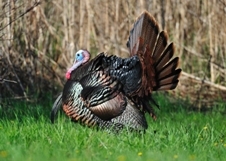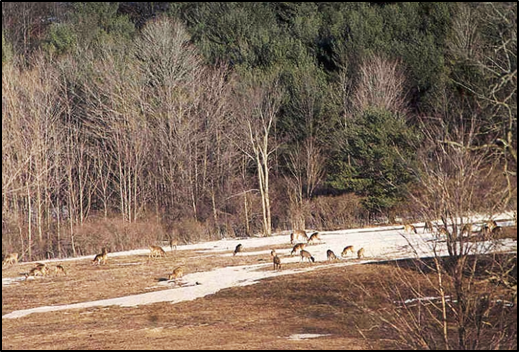Spring Turkey Season Opens May 1
 Spring turkey season opens May 1 in all of upstate New York north of the Bronx-Westchester County boundary. With reproductive success below the long-term average in 2016 and 2017, coupled with harsh winter conditions this year, it is anticipated that the spring harvest will be down from last year. However, good hunting opportunities can be found throughout the state, particularly in regions with good nesting and poult success the last two years. The estimated turkey harvest for spring 2017 was about 17,500 birds. Spring turkey season opens May 1 in all of upstate New York north of the Bronx-Westchester County boundary. With reproductive success below the long-term average in 2016 and 2017, coupled with harsh winter conditions this year, it is anticipated that the spring harvest will be down from last year. However, good hunting opportunities can be found throughout the state, particularly in regions with good nesting and poult success the last two years. The estimated turkey harvest for spring 2017 was about 17,500 birds.
View reports from DEC’s Summer Wild Turkey Sighting Survey
Important Details for the Spring Turkey Season, May 1 through 31, 2018:
- Hunting is permitted in most areas of the state, except for New York City and Long Island.
- Hunters must have a turkey hunting permit in addition to their hunting license.
- Shooting hours are from one-half hour before sunrise to noon each day.
- Hunters may take two bearded turkeys during the spring season, but only one bird per day.
- Hunters may not use rifles or handguns firing a bullet. Hunters may hunt with a shotgun or handgun loaded with shot sizes no larger than No. 2 or smaller than No. 8, or with a bow or crossbow.
- Successful hunters must fill out the tag that comes with their turkey permit and immediately attach it to any turkey harvested.
- Successful hunters must report their harvest within seven days of taking a bird. Call 1-866-426-3778 (1-866 GAMERPT) or report harvest online.
For more information about turkey hunting, see the 2017-18 Hunting and Trapping Regulations Guide or visit the DEC Website.
Avoid Problems with Bears
 As New York’s black bears emerge from their winter dens, they need to replenish their nutrients and body fat. Nearly all negative bear encounters in New York are the result of hungry bears being attracted to human food sources, primarily garbage and bird feeders. Bears often find human food readily accessible if homeowners don’t take precautions and these food sources can turn any bear into a problem bear. As New York’s black bears emerge from their winter dens, they need to replenish their nutrients and body fat. Nearly all negative bear encounters in New York are the result of hungry bears being attracted to human food sources, primarily garbage and bird feeders. Bears often find human food readily accessible if homeowners don’t take precautions and these food sources can turn any bear into a problem bear.
To reduce the chance of negative black bear encounters, take these simple precautions:
- Never feed bears! It is illegal, dangerous and detrimental to bears.
- If you know of bears being fed or of a nuisance bear situation, report to DEC immediately.
- Take down bird feeders after April 1. Birds don’t need supplemental food in the spring and summer, when natural foods are most abundant.
- Clean off barbeque grills before nightfall, and if possible, store grills inside.
- Store garbage in a sealed can inside a secure building or location, and dispose of garbage frequently.
- Put garbage containers by the curb just before the scheduled pick-up, never the night before.
- Consider using a certified bear-resistant garbage container.
- Clean garbage cans frequently with ammonia products.
- Do not burn garbage: it is illegal and can attract bears.
- Do not add meat scraps, bones or melon rinds to your compost pile.
- Feed pets indoors and store pet food indoors. If pets must be fed outside, immediately remove all uneaten food and dishes.
Please report problems with black bears to the Regional Wildlife Offices. To learn more about New York's black bears, visit the DEC Website.
Deer In Spring
 With lengthening days of spring, the whitetail’s body and habits begin to change. Fetal growth advances at a faster rate, taxing does’ bodies of remaining energy stores. Younger deer, whose growth had been suppressed during dormant winter months, is jump started. The increased day length also stimulates antler growth in bucks. With lengthening days of spring, the whitetail’s body and habits begin to change. Fetal growth advances at a faster rate, taxing does’ bodies of remaining energy stores. Younger deer, whose growth had been suppressed during dormant winter months, is jump started. The increased day length also stimulates antler growth in bucks.
These physical changes cause deer to become more active in an attempt to satisfy increasing energy needs. Deer vigorously seek out areas with the first new growth. It’s not uncommon to witness dozens of deer feeding in fields on south facing slopes or in lowlands where direct sunlight has warmed the soil, promoting the growth of tender green shoots.
All of this speaks to the importance of providing quality habitat for deer, especially for when winters are prolonged like we’ve experienced this year. Deer that enter winter in good nutritional condition because of quality summer and fall foods and ample winter cover, are better prepared to survive when snow persists through March and into April. Does that fare well through winter are more likely to birth heavier fawns, which are then more likely to survive and thrive. Bucks that fare well through the winter will get a head start over less healthy bucks and will grow more impressive antlers by the fall. With any luck, the young bucks you passed on during last hunting season are already putting on inches of new antler.
To ensure an overall healthy deer population, and to be most successful when you Let Young Bucks Go and Watch Them Grow, consider ways you can improve the quality of the habitat through forest management and creation of young forest.
|


 Spring turkey season opens May 1 in all of upstate New York north of the Bronx-Westchester County boundary. With reproductive success below the long-term average in 2016 and 2017, coupled with harsh winter conditions this year, it is anticipated that the spring harvest will be down from last year. However, good hunting opportunities can be found throughout the state, particularly in regions with good nesting and poult success the last two years. The estimated turkey harvest for spring 2017 was about 17,500 birds.
Spring turkey season opens May 1 in all of upstate New York north of the Bronx-Westchester County boundary. With reproductive success below the long-term average in 2016 and 2017, coupled with harsh winter conditions this year, it is anticipated that the spring harvest will be down from last year. However, good hunting opportunities can be found throughout the state, particularly in regions with good nesting and poult success the last two years. The estimated turkey harvest for spring 2017 was about 17,500 birds. As New York’s black bears emerge from their winter dens, they need to replenish their nutrients and body fat. Nearly all negative bear encounters in New York are the result of hungry bears being attracted to human food sources, primarily garbage and bird feeders. Bears often find human food readily accessible if homeowners don’t take precautions and these food sources can turn any bear into a problem bear.
As New York’s black bears emerge from their winter dens, they need to replenish their nutrients and body fat. Nearly all negative bear encounters in New York are the result of hungry bears being attracted to human food sources, primarily garbage and bird feeders. Bears often find human food readily accessible if homeowners don’t take precautions and these food sources can turn any bear into a problem bear. With lengthening days of spring, the whitetail’s body and habits begin to change. Fetal growth advances at a faster rate, taxing does’ bodies of remaining energy stores. Younger deer, whose growth had been suppressed during dormant winter months, is jump started. The increased day length also stimulates antler growth in bucks.
With lengthening days of spring, the whitetail’s body and habits begin to change. Fetal growth advances at a faster rate, taxing does’ bodies of remaining energy stores. Younger deer, whose growth had been suppressed during dormant winter months, is jump started. The increased day length also stimulates antler growth in bucks.